Western Digital Red Review: Are NAS-optimized HDDs Worth the Premium?
by Ganesh T S on August 17, 2012 4:20 PM EST- Posted in
- Storage
- NAS
- Western Digital
Performance Metrics and Power Consumption
The performance evaluation reports are organized under two categories: Standalone and NAS-based. In the latter case, we have two NAS systems which are not in the officially sanctioned list (LaCie 2big NAS and Netgear NV+ v2) and one recommended by WD as definitely compatible (Synology DS211+). As mentioned earlier, we present the equivalent performance numbers for the 3 TB Seagate Barracuda 7200 rpm drives. We make use of the standard single-client NAS testing methodology using NASPT / robocopy.
First, let us take a look at the HD Tune Pro benchmarks on the standalone drive.
The sequential access speeds vary between 59 MBps and 148 MBps depending on whether the outer or inner parts of the platter are being accessed. 4KB random accesses aren't going to win any performance benchmarks (the numbers reported by HD Tune Pro above aren't directly comparable with what we have reported using IOMeter in other HDD reviews).
The following graphs summarize the results from our NAS testing. In all configurations, the drives were put in RAID-1.
In order to put the final two graphs in perspective, we note that the standalone WD Red (freshly formatted) connected to a SATA 6 Gbps port of the Asus P8H77-M Pro delivered 130.07 MBps in the write test and 137.46 MBps in the read test. In the NAS systems, the WD Red performs quite well, particularly in the Synology DS211+. It does lose out to the Seagate 3TB hard drives under some circumstances. However, one can safely say that in 2 - 5 bay NAS systems based on ARM chipsets, it is unlikely that 7200 rpm drives are going to consistently deliver better performance than the 5400 rpm / IntelliPower drives.
In order to get an idea of how much power savings one can expect from using these drives, we took the LaCie 2big NAS and ran the disk performance bench using both the Seagate and WD drives in RAID-1 configuration. The following table summarizes the power consumption under various operating modes.
| LaCie 2big NAS Power Consumption | ||
| Mode | Seagate 3 TB | WD Red 3 TB |
| Sleep | 7.7 W | 7.7 W |
| 100% Read | 20.6 W | 14.8 W |
| 60% Rand, 65% Read | 21.2 W | 15.9 W |
| 50% Read | 20.9 W | 14.9 W |
| Rand 8K 70% Read | 20.6 W | 14.7 W |
It is interesting to see that the WD Reds consume just slightly more than two-thirds the power of the 7200 rpm drives when subject to similar accesses over the network. Of course, one might say that 7200 rpm drives such as the Seagate one we used above are not suitable for NAS applications at all. However, note that LaCie had in fact bundled them with their 2big NAS with the OS pre-installed.






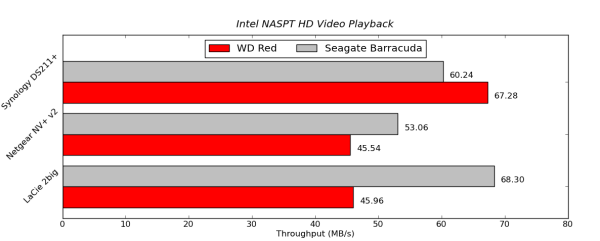
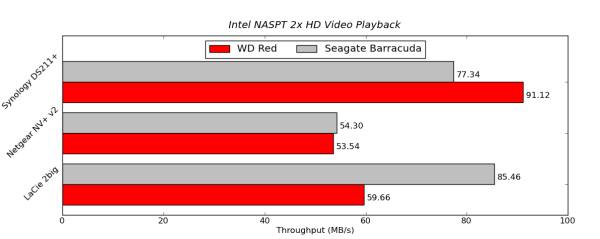
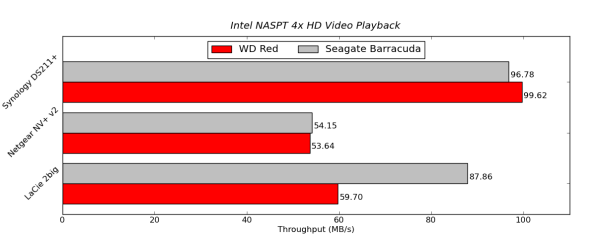
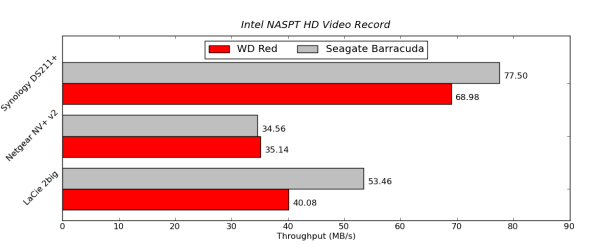
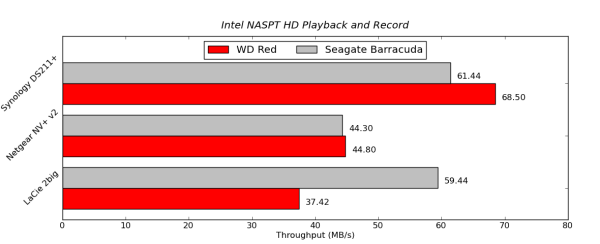
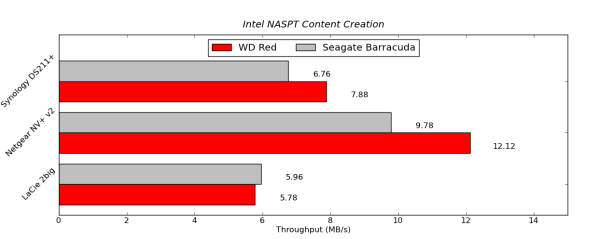

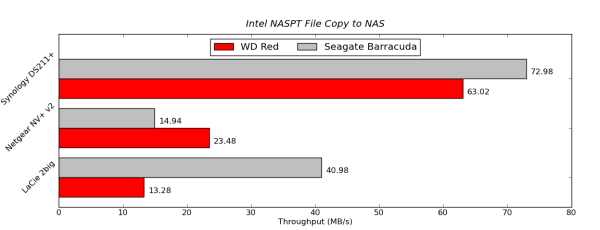
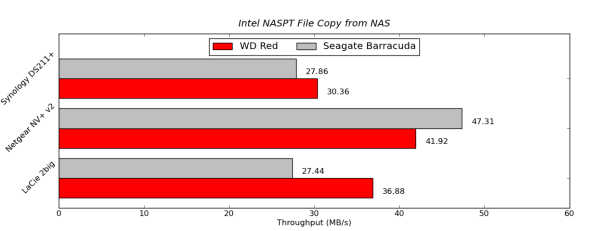
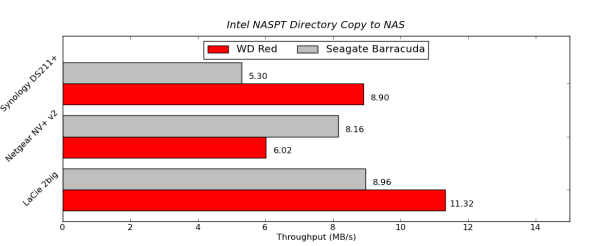
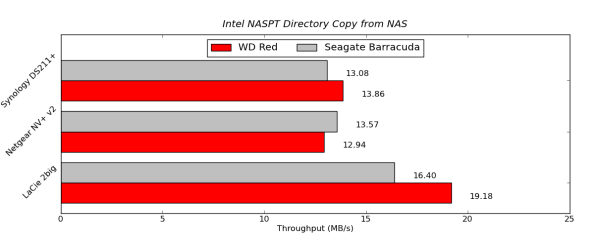
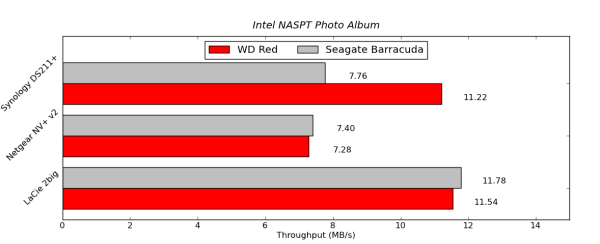
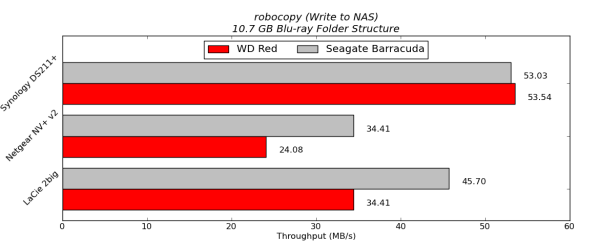
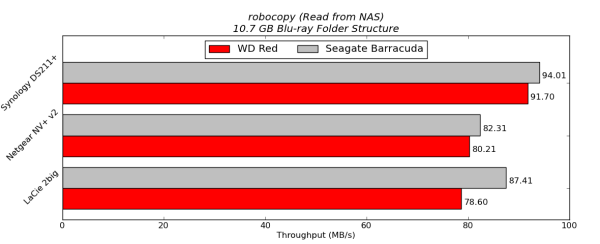








87 Comments
View All Comments
MrSpadge - Saturday, August 18, 2012 - link
Simple: use the right tool for the job.kmmatney - Thursday, August 23, 2012 - link
I work for a small company and we use consumer-class hardware fairly often for non-essential tasks. You have to, when working on a project with a limited budget.hsew - Friday, August 17, 2012 - link
I remember reading somewhere that Intellipower was unsuitable for RAID due to the fact that it is not a set spindle speed, rather a sweet spot speed determined in manufacturing. If it is in fact true that Intellipower is unsuitable for RAID, that would make these far less appealing as NAS drives. If I wanted to have a NAS I would want at least two drives in RAID 1. Why is WD shying away from 5400 RPM? It HAS a place, low power data storage!jwilliams4200 - Friday, August 17, 2012 - link
Why don't you read the article before you comment?hsew - Friday, August 17, 2012 - link
Because Ctrl+f didn't lead to any specific discussion on aforementioned issue...ganeshts - Friday, August 17, 2012 - link
Well, that is marketing for you :) 'People don't like lower numbers, so let us just give it a name' must have been what the WD Marketing team must have thought.FWIW, all concrete proofs of the spindle speed that I have seen online point to 5400 rpm for IntelliPower drives.
Wwhat - Sunday, August 19, 2012 - link
I think you are wrong actually, WD has drives that they use the number 5400 for, it's no real issue these days because with high density 5400 is fast enough.And I think they actually have changeable speed drives that probably max at 5400 but also ones that max at 7200 because they have a 'green' type and non-green types with the variable speed technology, so I'm prretty sure it's not some euphemism. And I also think people are more positive to numbers when it comes to HD's rather than the unspecified 'variable', it's more a risky move for WD I would say.
EnzoFX - Friday, August 17, 2012 - link
Is it me or was there no prices listed? or maybe a comparison for someone debating between reds and greens =P.ganeshts - Friday, August 17, 2012 - link
Prices are all over the park. IIRC, the 3TB version launched at $189 [ http://www.anandtech.com/show/6083/wd-introduces-r... ], but it is at $240 on Newegg right now.. I guess I left it to the reader to do the price comparison at the time of purchase :) But, thanks for mentioning.. it really was an oversight :)adrianblack - Friday, August 17, 2012 - link
I must point out the WD AV-GP line which has been out for a while were designed for 24/7 continuous and high-temp operation. I have two of these drives in my server now..... (The older 1.5TB drive has been in there for 2.5 years)WD says:
"24x7 reliability: These drives are designed to last in high temperature always-on streaming digital audio/video environments such as PVR/DVR, IPTV, and video surveillance systems."
The downside of the AV-GP line was they didn't have the idle-parking disabled, so you did have to use WDIDLE first to fix that problem. (I accumulated 245k cycles on my older 1.5TB drive before I disabled auto-park.) They have 1 million hour MTBF, some kind of optimization for better video streaming and PWL which they call preemptive wear leveling.
So pretty similar to the RED which add the vibration mitigation and a default disable on the IDLE-Park. (WD states 1 million hour MTBF on the RED drives, by the way.)